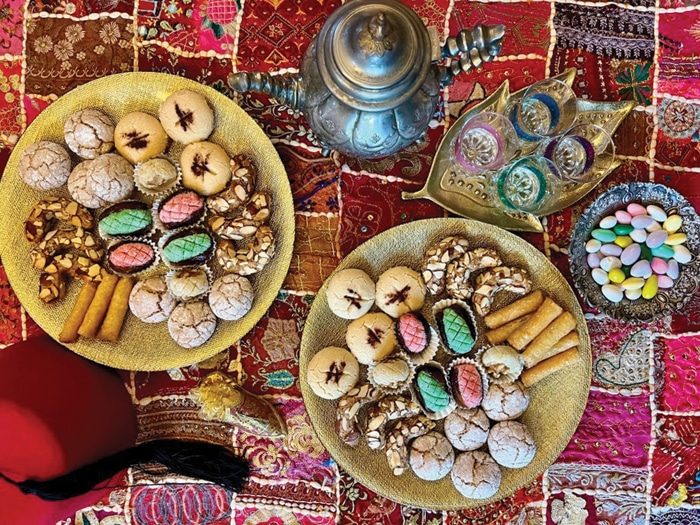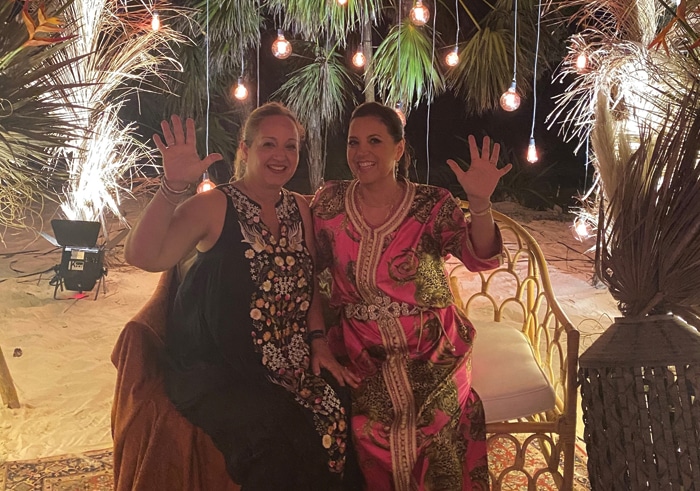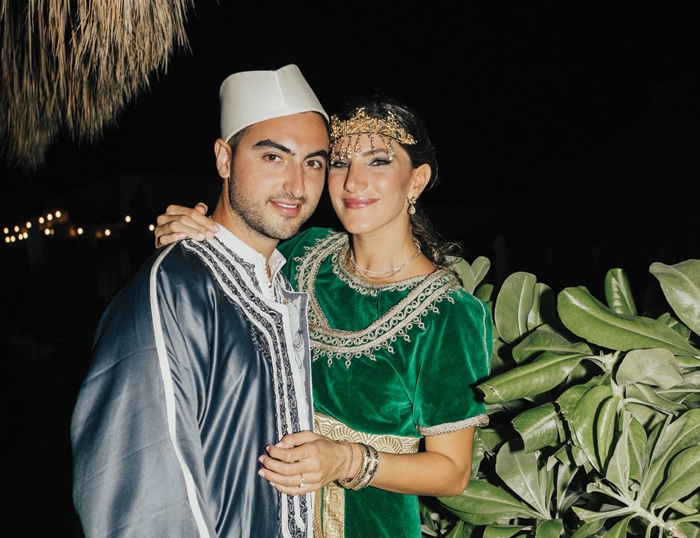 Photo by Alexandra Gomperts
Photo by Alexandra Gomperts The vibe was Old World charm meets New World chic when Rachel and Neil hosted their son’s henna party.
Marrakesh was magically transplanted to the beach of Chable Maroma on the Mexican Riviera, with Moroccan lanterns flickering with candlelight setting the scene. There were hanging ropes of twinkle lights and huge floral displays filled with deep red, coral and pink roses, flaming red tropical plants and feathery plants. The tables were covered with ochre linens and dark green palm fronds, as well as adorable miniature red fezzes and gold and burgundy Moroccan slippers filled with jordan almonds. Antique Persian rugs and Turkish Kilim rugs were scattered on the sand and bamboo chairs and overstuffed cushions provided seating.

The arus and arusa, the engaged couple, made their grand entrance on wooden trays carried by their friends. They were accompanied to their throne by pulsing Middle Eastern music, exuberant cheers and the bride’s girlfriends carrying wrapped trays of Moroccan cookies.
The bride, Estrella, was resplendent in a custom made emerald green velvet caftan with gold braid trim and a gold headband with dangling jewels. This native Berber gown is called K’sou’ah K’bira in Arabic, Vestido de Berberisca in Spanish and La Grande Robe in French. It was traditional wedding garb for Moroccan Jews until 1840, when Queen Victoria wed Prince Albert, popularizing white wedding gowns.
The groom was all smiles and very handsome in his dark grey satin and white brocade jalabiya with his short white fez set at a rakish angle on his head.
— Sharon
While my mother’s family had a Berberisca gown that we used for many, many generations, it landed up in Israel when my grandparents made Aliyah. The gown Estrella wore was lent to her by Rachel Bazini, whose mother sewed caftans for the Queen of Morocco. The gown, which dates from the 1960’s, is priceless. I carried it on the plane in my hand luggage, scared to let it out of my sight for one second.
Sam, and my other children Max and Rebekah, Neil and I wore caftans from the exquisite collection of our good friend and Sephardic Educational Center SEC alum Martine Ezekiel, who adds to her collection every time she travels to Morocco.
I still can’t believe that I stood up on a chair and made a speech at my son’s henna ceremony!

I was filled with memories of my own henna, 30 years earlier. My mother and cousin Alia dressed me in a Berberisca gown borrowed from a family friend that was over a hundred years old and adorned me with piles of gold jewelry. My father’s sister Clara came from Rabat, Morocco and she, my mother’s sister Clara and my cousins cooked a huge feast.
In my speech, I explained to all the guests that henna is used as a symbol to protect the couple from the evil eye, to bring them a blessing of mazal, health and fertility. And that the couple are like a king and queen. I blessed them to have a long happy, fruitful life together.
Then we performed the Henna ceremony for the bride and groom. We mixed henna powder with perfume and rose water to make a paste. We pressed it into the palms of their hands with a gold coin and we bound their hands together to signify their unity.
Then each guest received a dab of henna the size of a coin on the palm of their hand to symbolize prosperity for the couple.
The festivities continued with abundant trays of grilled meats, kebabs and couscous.
And for dessert there were exquisitely sweet, nut filled and perfumed Moroccan delicacies. Rachel Bazini of @bazinibread did an incredible job baking dozens of traditional cookies. Ghribbas, a crumbly shortbread cookie. Cigars, a fried brik pastry stuffed with almond paste and doused in a honey syrup. Hazelnut moons. Almond macarons. Dates and walnuts stuffed with marzipan.
Then we literally danced the night away. A Henna that our friends and family will never forget.
L’Chaim! To Life!
— Rachel
Marzipan dates and walnuts have been served at every family celebration for as long as I can remember.
When my son Sam flew to Miami to propose to Estrella, I sent a box of homemade marzipan-stuffed dates with him. Marzipan dates and walnuts have been served at every family celebration for as long as I can remember.
While Neil and I couldn’t be there because of the pandemic, these sweets were a symbol of our family history and our love for the young couple.
In the past, making marzipan was very time consuming. The almonds had to be prepared with boiling, removing the skins and grinding. Nowadays, almond flour is readily available. The marzipan I sent to Miami was prepared with egg whites, like my mother used to make. But recently our friend Kaye Israel, from the blog Bendichas Manos, shared her new, improved easy recipe which omits egg whites.
For the real Moroccan touch, I added almond extract or orange blossom water to our recipe.
We hope you prepare this delightful dessert for your next celebration. They’ll brighten your table and your guests will be amazed!
— Rachel
Moroccan Marzipan Dates
36 large Madjool dates
2 cups almond flour
1 ¼ cups confectioners sugar
¼ cup water
1 teaspoon almond extract
1 teaspoon orange blossom water
or rose water
- Make a horizontal slit in each date (do not cut all the way through) and remove the pits.
- In a food processor fitted with a blade, combine the almond flour and sugar, slowly add the water a few drops at a time and add the almond extract or orange blossom water.
- When mixture starts to form a dough, pulse 10 times.
- Divide the mixture into two bowls. Add a few drops of red food coloring in one and green food coloring in the other. Knead each dough separately, making sure not to stain with the other color.
- Allow mixture to sit for one hour.
- Roll small cylinders of almond paste, the same length as the dates, but half the diameter. Then stuff each date.
- Score the exposed almond paste with the dull side of a paring knife to create a diamond pattern, then roll the date in sugar.
- Store the stuffed dates in an airtight container.
- Marzipan can also be used to stuff prunes and walnuts.
Sharon Gomperts and Rachel Emquies Sheff have been friends since high school. They love cooking and sharing recipes. They have collaborated on Sephardic Educational Center projects and community cooking classes. Follow them on Instagram @sephardicspicegirls and on Facebook at Sephardic Spice SEC Food. Website: sephardicspicegirls.com/full-recipes























 More news and opinions than at a Shabbat dinner, right in your inbox.
More news and opinions than at a Shabbat dinner, right in your inbox.